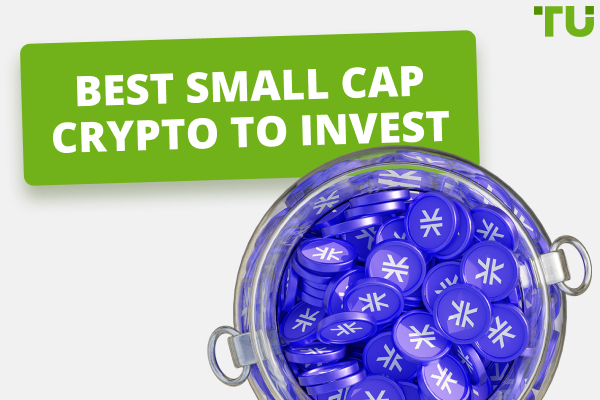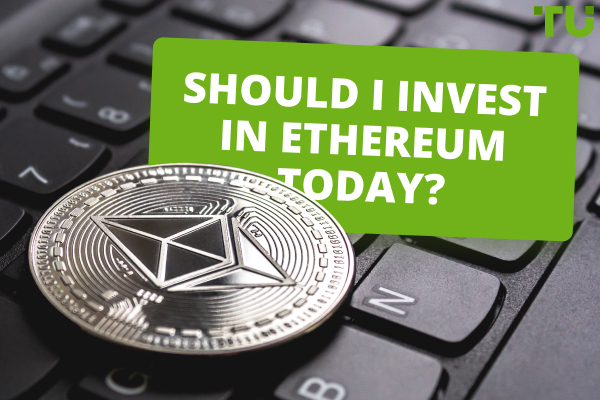Top 10 Strategies To Day Trade Cryptocurrencies
The best crypto day trading strategies in 2024 are:
-
Momentum Trading - Buying recently outperforming stocks showing further strength and selling recently underperforming stocks showing further weakness
-
Reversal Trading - Taking positions in anticipation of trend reversals
-
Breakout Trading - Looking for near-end consolidation phases to take positions that would benefit from a breakout or breakdown
-
Moving Average Crossovers - Technical Indicator-based trading that incorporates both long term and short term price trends
-
Scalping - Taking multiple trades within quick time intervals to capture profits from small price movements
-
High-Frequency Trading (HFT) - Making use of trading algorithms that go in and out of trades faster than human capabilities allow for
As cryptocurrencies continue to capture global attention, day trading the asset class has emerged as an enticing avenue for potential profits. So, in this rapidly evolving landscape, the pursuit of the best strategies becomes paramount. To address the same, the experts at TU have in this guide explored the most effective crypto day trading strategies in 2023.
Start trading cryptocurrencies with ByBitWhat is crypto day trading?
Crypto day trading represents a dynamic strategy that makes the most of the fast-paced nature of the cryptocurrency market. This approach involves buying and selling digital assets within the same trading day, taking full advantage of the unique liquidity and volatility found in the world of cryptocurrencies. To be profitable, traders are increasingly learning how to extract profits from even the smallest price fluctuations, capitalizing on the crypto market's inherent price swings. Maybe, you also interested in information how to turn $100 into $1000 in crypto trading.
To start this journey, it's crucial to have a well-structured crypto day trading strategy or, at the very least, a solid grasp of general cryptocurrency trading principles. This foundation is essential because crypto day traders must possess the ability to decipher intricate chart patterns, analyze trading volumes, interpret price movements, and assess various indicators. These skills empower traders to identify opportune moments to buy and sell, ultimately driving their profitability.
At the heart of successful crypto day trading lies technical analysis. This analytical approach equips traders with the tools needed to make informed investment decisions. By scrutinizing crypto chart patterns, closely monitoring trading volumes, and assessing price actions, traders can uncover valuable insights that guide their trading moves.
Best crypto day trading strategies
As the crypto day trading landscape unfolds in 2023, traders are presented with a diverse toolkit of strategies to navigate the ever-volatile cryptocurrency market. Here, the experts delve deeper into these strategies to help you gain a comprehensive understanding of how to best employ them.
1. Momentum Trading
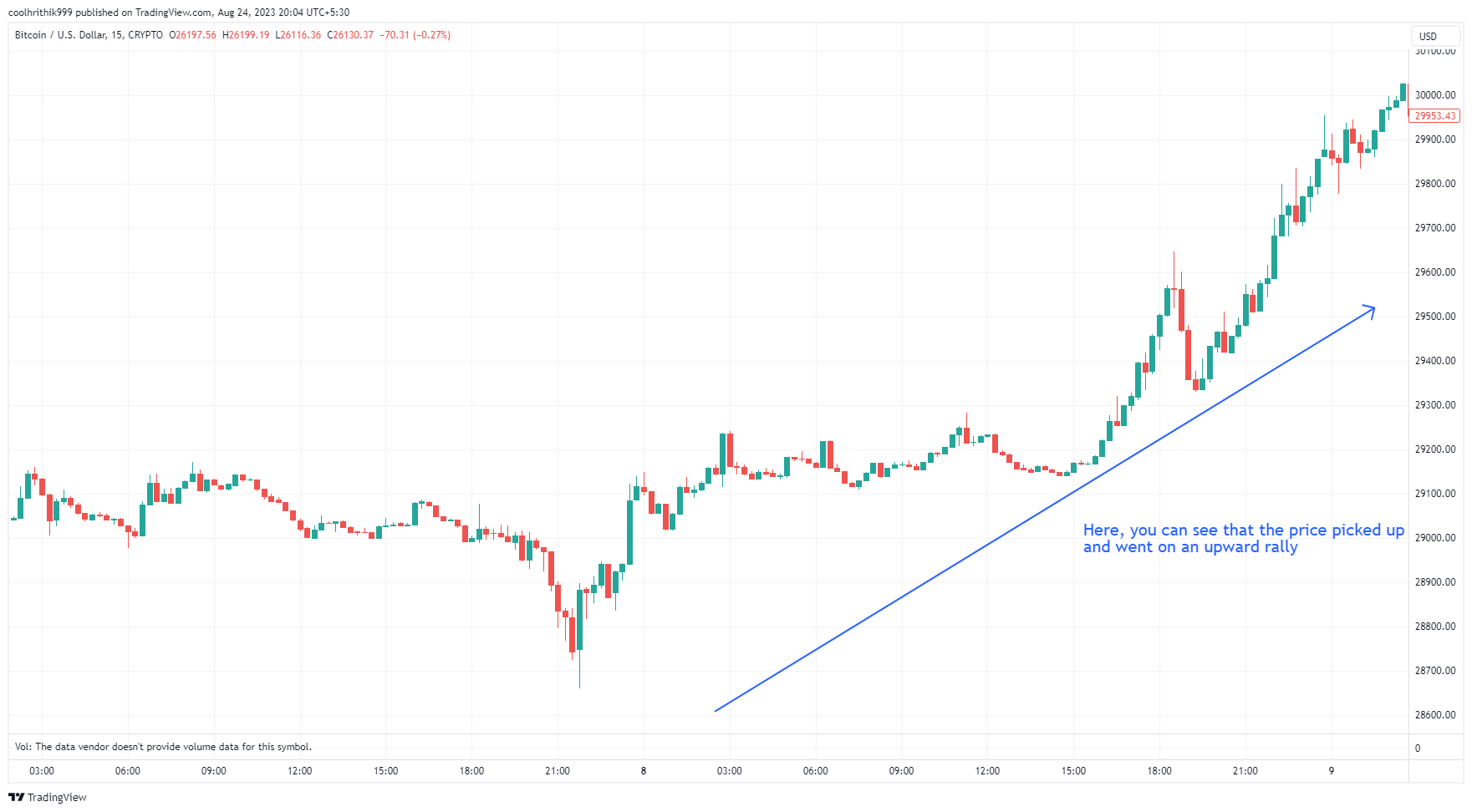
Momentum Trading Illustration – Bitcoin
Momentum trading is akin to catching a wave in the cryptocurrency sea. It revolves around identifying assets that are on the move, either surging upwards or plummeting. A trader following this strategy would try entering trades that align with the prevailing trend. For instance, if a particular cryptocurrency is experiencing significant price growth, a momentum trader would aim to ride this wave by buying into the asset with the expectation that the upward momentum will persist.
Successful momentum trading necessitates thorough research and technical analysis to pinpoint the opportune moments to initiate or exit trades. Timing is crucial, as traders aim to capitalize on rapid price changes driven by market sentiment and external factors.
2. Reversal Trading
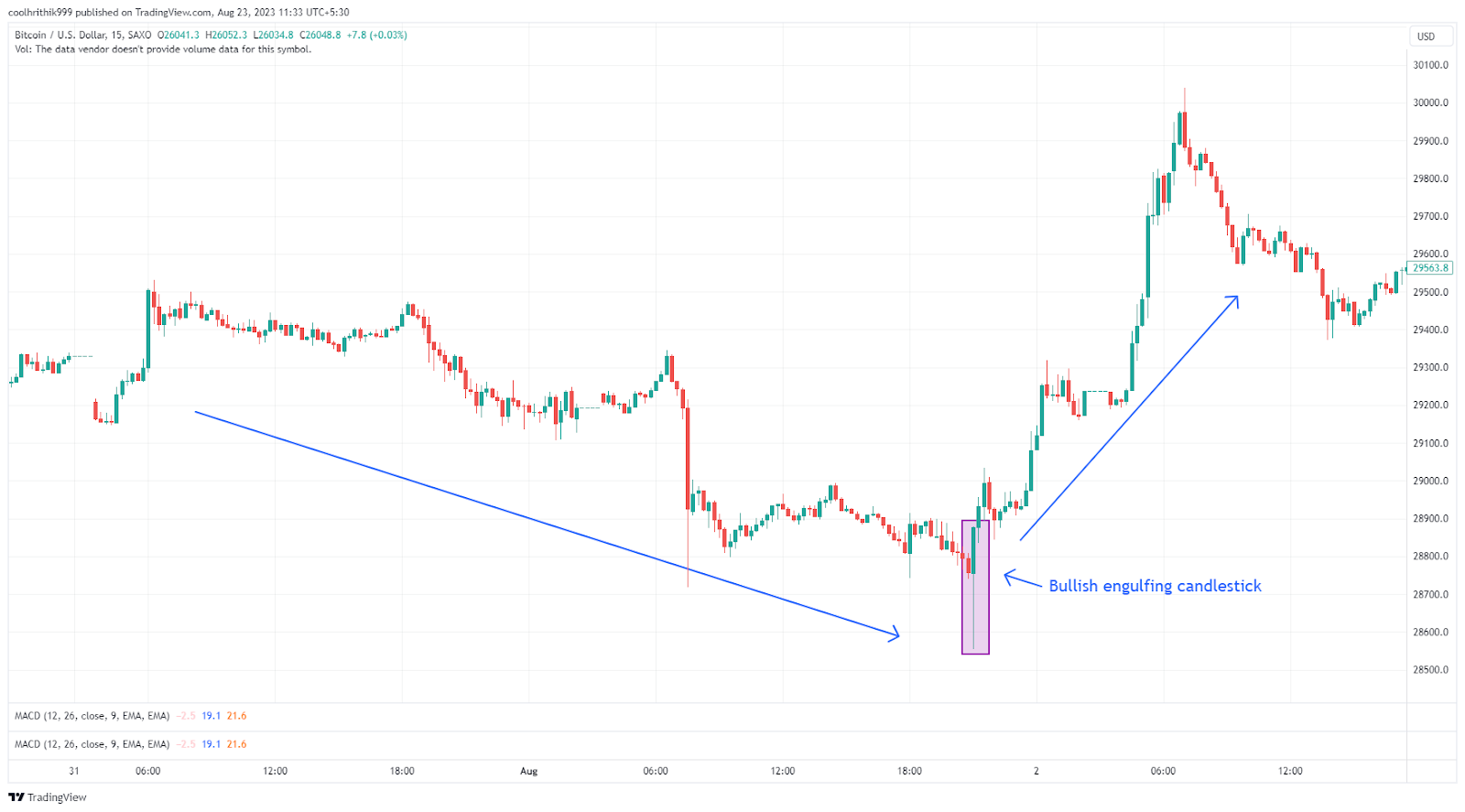
Reversal Trading Illustration – Bitcoin
Reversal trading, in contrast, seeks to identify assets that have undergone substantial price movements and then takes positions based on the anticipation of a price reversal. When a cryptocurrency experiences a sharp price drop, a reversal trader anticipates a rebound, while the reverse holds when an asset's price has surged significantly.
Just like momentum trading, executing reversal strategies effectively requires comprehensive research and technical analysis. Traders need to accurately identify the tipping points where a trend is likely to reverse, allowing them to enter trades at the most advantageous moments.
3. Breakout Trading
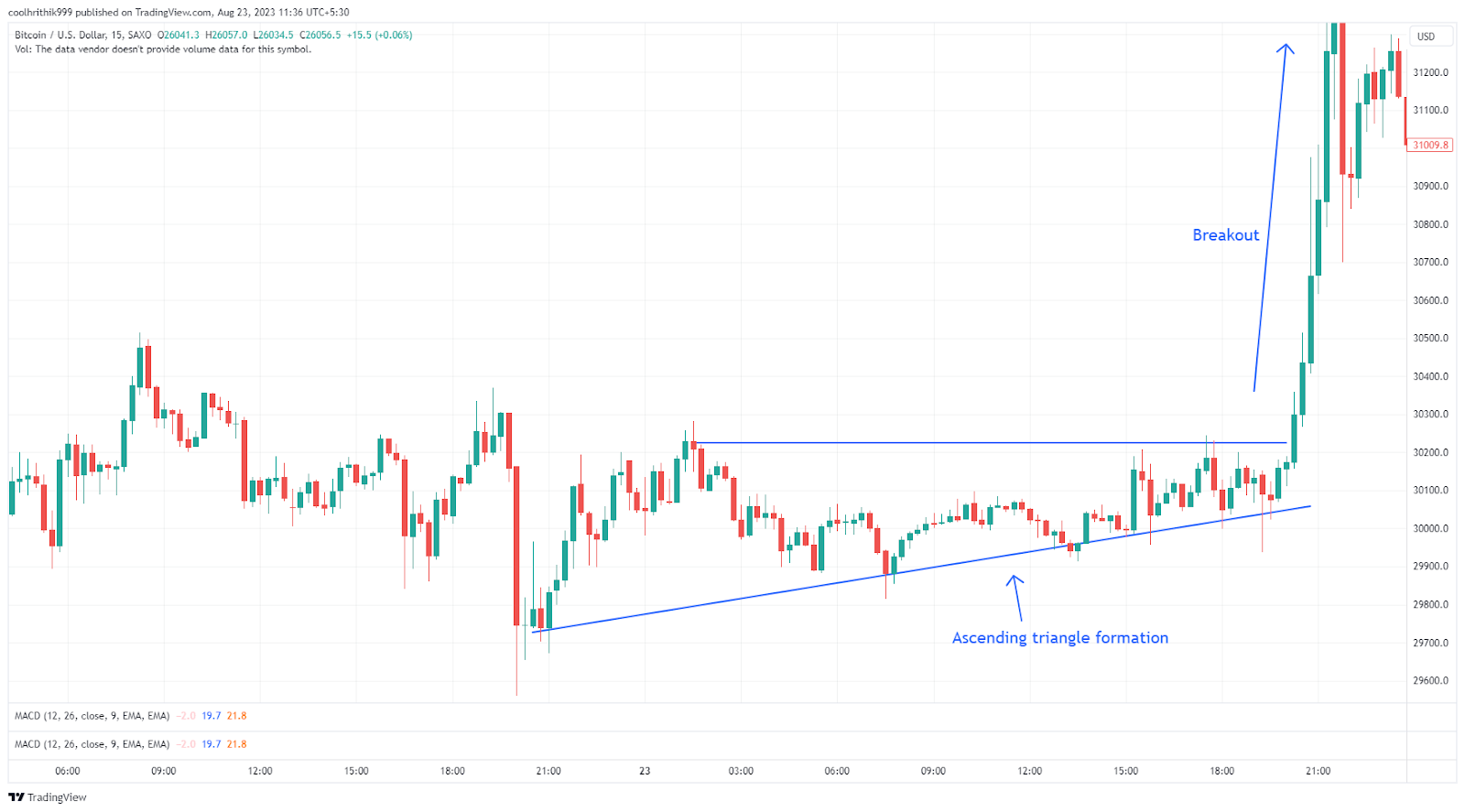
Breakout Trading Illustration – Bitcoin
Breakout trading is all about identifying assets that have broken free from established trading ranges or patterns and capitalizing on the expectation that these price movements will continue. This strategy hinges on identifying cryptocurrencies that have breached a predefined price range—either breaking out above or dropping below it. Traders then enter positions with the belief that the price momentum will persist in the breakout direction.
Effective breakout trading relies on meticulous technical analysis and vigilant market monitoring. Traders must be adept at identifying key support and resistance levels, as well as recognizing chart patterns that indicate imminent breakouts.
4. Moving Average Crossovers
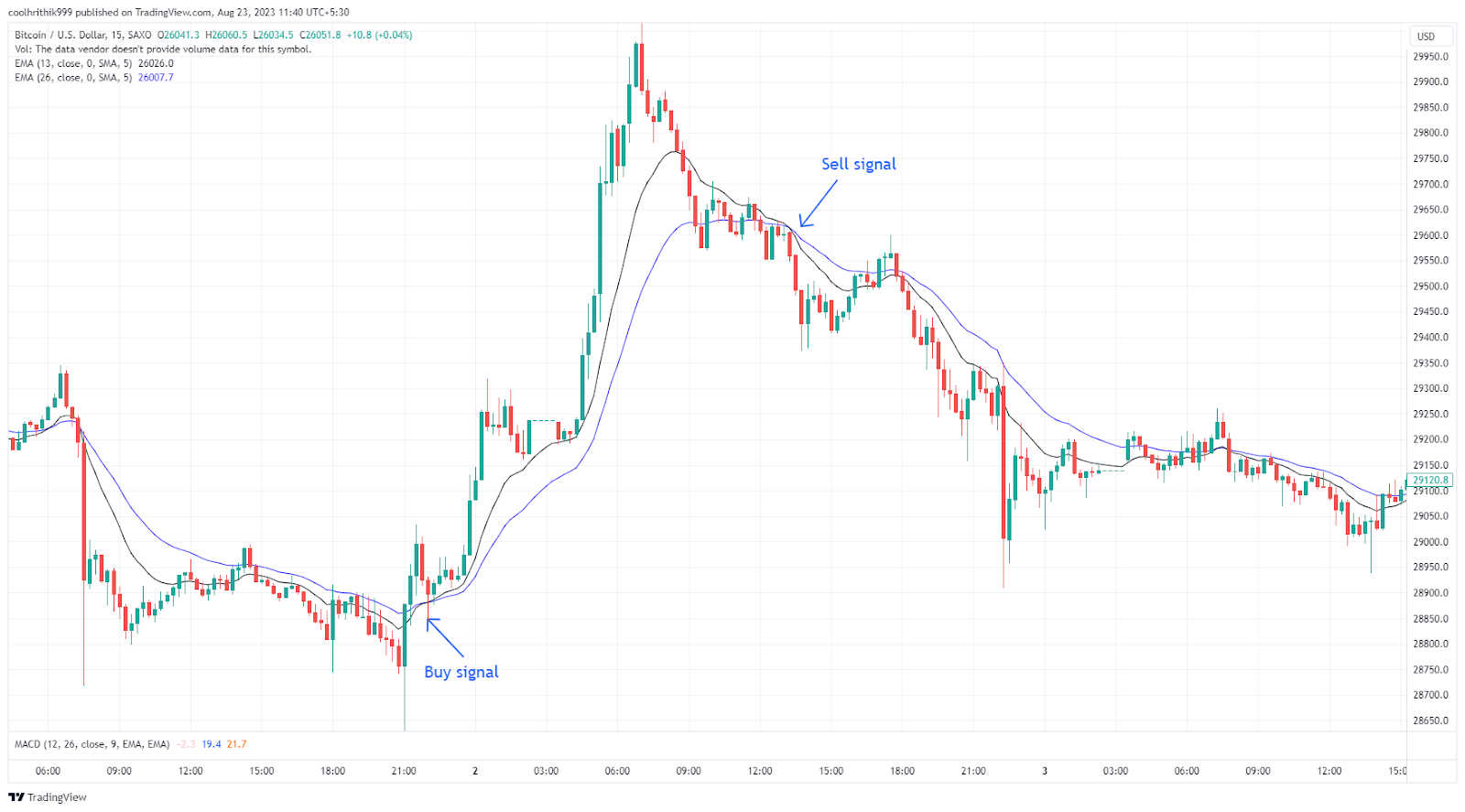
Moving Average Crossovers Illustration – Bitcoin
Moving average (MA) crossovers offer a more technical approach to day trading. MAs are lagging indicators that provide a smoothed-out representation of an asset's price over a specified time frame. Trading based on MA crossovers involves examining the intersection of different MAs.
For example, when a shorter-term MA crosses above a longer-term one, it often signals a buy opportunity, suggesting that an uptrend may be in progress. Conversely, when the shorter-term MA crosses below the longer-term one, it could indicate a sell opportunity, potentially signifying a downtrend. In all, MA crossovers provide traders with valuable insights into potential trend changes, helping them make informed decisions.
5. Scalping
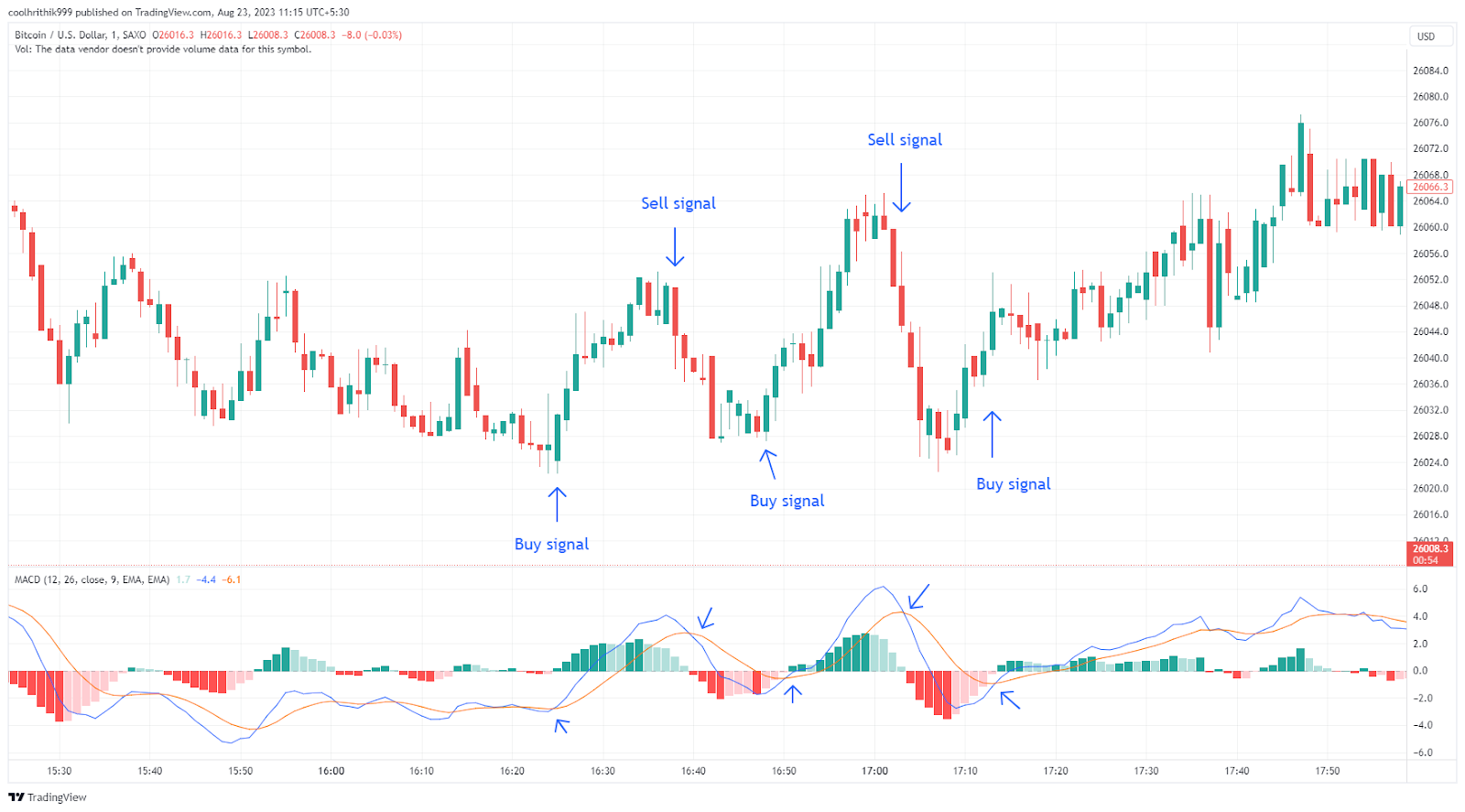
Scalping Illustration – Bitcoin
Scalping strategy is all about rapid-fire trading, where traders aim to profit from short and swift price fluctuations. Scalpers, often relying on automated trading bots, frequently execute trades within minutes or even seconds. This approach is characterized by high trade frequency, substantial trading volumes, and larger position sizes. However, the targeted price changes are relatively small compared to longer-term strategies.
While scalping can be profitable, it's also risky. Reliable patterns are harder to identify within shorter time frames, and trading costs can erode profits. Strict adherence to an exit strategy is paramount to mitigate the risk of significant losses outweighing multiple small gains.
Scalping can be executed in two primary ways: the high-frequency approach involves a large number of trades, while a slower variant focuses on slightly larger price movements, fewer trades, smaller position sizes, and slightly longer holding periods.
In the specific illustration presented, the use of MACD indicator is being done to support scalping decisions. Note that signals generated by the indicator with low volumes on histogram are avoided, which is a specific caveat of this indicator.
6. Range Trading
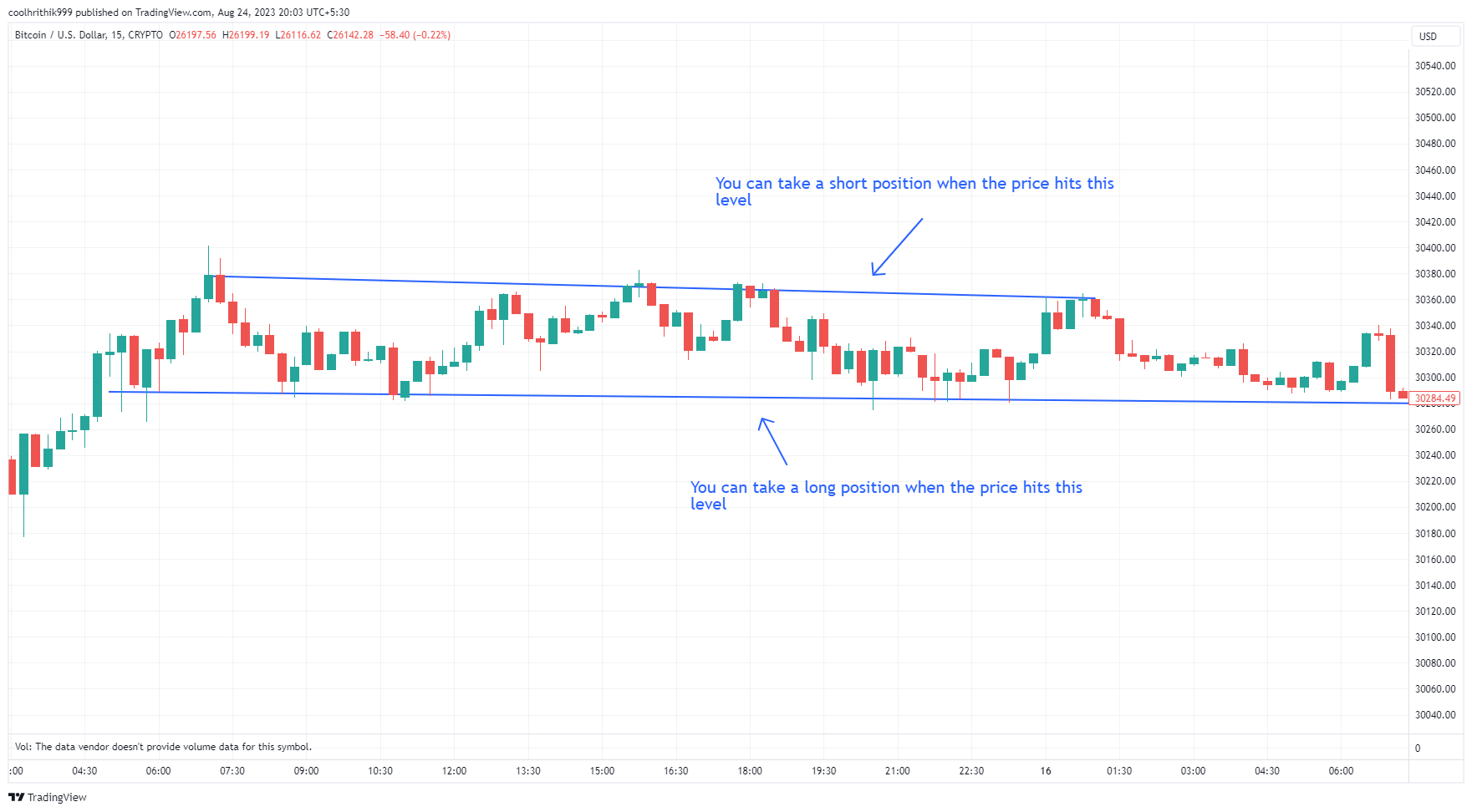
Range Trading Illustration – Bitcoin
Range trading is an approach that thrives in periods of market consolidation, where cryptocurrency prices oscillate within defined boundaries. These boundaries are determined by key support and resistance levels, often represented by classic consolidation patterns such as rectangles or symmetrical triangles.
In range trading, traders aim to enter short positions near the upper range where resistance is encountered or initiate long positions near the lower range around support levels. To manage risk, stop-loss orders are placed beyond the extremities of the defined range.
7. Long Straddle
The Long Straddle strategy is a volatility-driven approach that seeks to capitalize on significant price movements. This method involves purchasing both a put and a call option for the same cryptocurrency, featuring identical strike prices and expiration dates. The underlying premise is that while one side of the trade may incur losses, the profit from the winning position is expected to outbalance these losses, resulting in a net gain.
Long Straddle is a versatile strategy that can be especially advantageous during periods of market uncertainty or impending news events, where price swings are anticipated. Moreover, in highly volatile assets like cryptocurrencies, this strategy may yield considerable returns for those having a higher risk appetite.
8. High-Frequency Trading (HFT)
High-Frequency Trading (HFT) compliments well with the lightning-fast pace of the crypto market. Driven by sophisticated algorithms, HFT traders execute a barrage of orders in fractions of a second, leveraging predetermined criteria. These algorithms manage a significant volume of orders with the goal of profiting from minuscule price fluctuations over extremely brief intervals, often just seconds.
The cornerstone of HFT success is its ability to optimize execution speed while minimizing transaction costs. This efficiency not only ensures rapid trade execution but also enhances market liquidity. Trading bots play a pivotal role in executing these rapid-fire transactions, making HFT one of the most dynamic strategies in the crypto day trading arena.
9. Crypto Arbitrage
Crypto arbitrage traders are opportunists who seek to exploit short-term price differences between various cryptocurrency exchanges. They buy crypto at a lower price on one exchange and swiftly sell it at a higher price on another, or vice versa. Speed is of the essence in crypto arbitrage, and traders often rely on automated tools to seize arbitrage opportunities promptly.
To maximize returns, keeping trading costs low is crucial, given the frequency of transactions involved in arbitrage trading.
10. News Analysis
For any cryptocurrency trader, staying informed about news events that can significantly impact prices is indispensable. News analysis involves monitoring various news sources, forums, and social media platforms to gauge market sentiment. This information complements other analytical methods by providing a qualitative perspective on market dynamics.
Advanced traders often use RSS aggregators and sophisticated, event-driven news services that leverage complex algorithms to identify news activities capable of moving crypto markets. Being aware of the latest developments, regulatory changes, and project updates can give traders an edge in making timely decisions.
How to get started with crypto day trading?
Here’s how you can approach crypto day trading as a beginner:
1. Understanding the market dynamics
To find success, aspiring traders must grasp the intricate dynamics of the cryptocurrency market. The first step involves selecting a cryptocurrency for day trading, such as Bitcoin, that exhibits potential for predictability based on your personal skillset. Then, you should study the fundamentals of that crypto and analyze its charts to get used to the inherent price changes that govern the currency.
2. Choose the right trading exchange
The next crucial move is to create an account on a trading exchange that aligns with your day trading goals. Crypto markets are decentralized and subject to diverse regulations globally, so selecting a suitable platform is essential. Consider factors like user experience, fees, security measures, the variety of supported cryptocurrencies, and funding methods to ensure a seamless trading experience.
3. Initiate your investment capital
After settling on a dependable crypto exchange, the next step is to deposit your initial capital and commence your journey. While it might be possible to begin with just a few dollars since many crypto exchanges have low minimum trade requirements, profitability hinges on the development of an effective day trading strategy.
How to choose a cryptocurrency for day trading?
Choosing the ideal cryptocurrency for day trading hinges on several critical factors, each tailored to your unique circumstances and goals.
1. Evaluate your experience and skill level
If you're relatively new to the crypto world or day trading in general, it's advisable to start with a cautious approach. This involves opting for larger-cap coins, those with substantial market capitalization, and relatively high trading volumes.
2. Account size
If your account is on the smaller side, it's prudent to focus on cryptocurrencies that offer lower risk profiles. Larger-cap coins generally exhibit greater stability and are less prone to extreme price fluctuations compared to smaller, lower-cap coins.
3. Begin with top 30 cryptocurrencies
A sensible starting point for most day traders is to consider the top 30 cryptocurrencies based on market capitalization. These coins are well-established, widely recognized, and tend to have higher liquidity levels. Starting here allows you to immerse yourself in a lower-risk trading environment while honing your skills.
Things to avoid while crypto day trading
Crypto day trading in 2023 offers exciting opportunities, but it's equally crucial to be aware of potential pitfalls that can erode your profits and hinder your progress. Here are some critical things to steer clear of:
1. Overtrading
Overtrading, the temptation to make an excessive number of trades in a short period, can have detrimental consequences. It often leads to increased trading fees, slippage, and susceptibility to market volatility. To avoid overtrading, stick to a well-thought-out trading plan with predetermined entry and exit points. Always remember, patience is the key; not every market movement requires a trade.
2. Emotional trading
Decisions based on emotions, such as fear and greed, can cloud your judgment and lead to irrational choices. To mitigate this risk, maintain a disciplined mindset and adhere to your trading plan. Embrace losses as part of the process and avoid chasing quick gains driven by emotions.
3. Lack of risk management
Always have a robust risk management plan in place to limit potential losses. Utilize stop-loss orders to safeguard your capital and never risk more than you can afford to lose. By setting clear risk parameters, you can protect your assets and trade with confidence.
4. Chasing trends and FOMO
Avoid falling into the trap of chasing trends driven by hype and FOMO (fear of missing out). While these trends can be enticing, they are often short-lived and can result in losses. If you choose to engage in trend trading, stick to a well-researched momentum strategy, and exercise discipline. Emotional impulses can lead to costly mistakes.
5. Trading without a plan
Trading without a clear plan and strategy is akin to navigating uncharted waters without a map. Without a plan, you become susceptible to impulsive decisions and poor trade execution. Ensure that you have a well-defined trading plan that outlines your goals, risk tolerance, entry and exit points, and overall strategy.
Tips to keep in mind while day trading crypto
Here are some expert tips to keep in mind as you embark on your day trading journey in 2023:
1. Start with a small investment
Especially if you're a beginner, start-off small and slow. This approach allows you to gain experience and understanding of the crypto market without exposing yourself to excessive risk. Only invest what you can afford to lose; this precaution is fundamental to prudent trading.
2. Develop a well-defined trading strategy
A robust trading strategy is the bedrock of successful day trading. Consider various approaches, such as high-frequency trading (HFT) employing trading bots, scalping for incremental profits from frequent trades, or range trading based on price movements. Your chosen strategy should align with your risk tolerance and trading goals.
3. Set realistic profit targets and stick to them
In the fast-paced crypto market, it's easy to succumb to greed during moments of high volatility. To counter this, establish realistic profit targets for each trade and adhere to them rigorously. A clear exit strategy prevents you from falling into the trap of chasing unsustainable gains.
4. Utilize technical analysis
Leverage technical analysis tools and indicators to identify optimal entry and exit points for your trades. These tools provide valuable insights into market trends and patterns, aiding you in making well-informed decisions.
5. Implement risk management strategies
Risk management is paramount in day trading. Employ tactics like setting stop-loss orders to limit potential losses. Having a well-structured risk management plan safeguards your capital and ensures that one bad trade doesn't derail your overall strategy.
6. Stay informed with market news
Keep a watchful eye on the latest news and developments in the crypto market. News can have a profound impact on cryptocurrency prices. Staying updated empowers you to make informed trading decisions based on current events, regulatory changes, and market sentiment.
Best platforms for crypto day trading


FAQs
Which crypto will boom in 2024?
While it's challenging to predict the exact cryptocurrency that will boom in 2024, popular choices include Bitcoin, Ethereum, and some emerging altcoins.
Is crypto trading profitable in 2024?
Yes, crypto trading can be profitable in 2024, but it carries risks. Success depends on strategy, research, and market conditions.
What is the most profitable crypto in 2024?
The most profitable crypto can vary, but Bitcoin and Ethereum are often considered among the top contenders given their long track record of survival with growth.
Will crypto rise again in 2024?
Cryptocurrency markets are volatile; while rises are possible, predicting specific outcomes remains uncertain.
Glossary for novice traders
-
1
Broker
A broker is a legal entity or individual that performs as an intermediary when making trades in the financial markets. Private investors cannot trade without a broker, since only brokers can execute trades on the exchanges.
-
2
Trading
Trading involves the act of buying and selling financial assets like stocks, currencies, or commodities with the intention of profiting from market price fluctuations. Traders employ various strategies, analysis techniques, and risk management practices to make informed decisions and optimize their chances of success in the financial markets.
-
3
Day trading
Day trading involves buying and selling financial assets within the same trading day, with the goal of profiting from short-term price fluctuations, and positions are typically not held overnight.
-
4
Cryptocurrency
Cryptocurrency is a type of digital or virtual currency that relies on cryptography for security. Unlike traditional currencies issued by governments (fiat currencies), cryptocurrencies operate on decentralized networks, typically based on blockchain technology.
-
5
Bitcoin
Bitcoin is a decentralized digital cryptocurrency that was created in 2009 by an anonymous individual or group using the pseudonym Satoshi Nakamoto. It operates on a technology called blockchain, which is a distributed ledger that records all transactions across a network of computers.
Team that worked on the article
Chinmay Soni is a financial analyst with more than 5 years of experience in working with stocks, Forex, derivatives, and other assets. As a founder of a boutique research firm and an active researcher, he covers various industries and fields, providing insights backed by statistical data. He is also an educator in the field of finance and technology.
As an author for Traders Union, he contributes his deep analytical insights on various topics, taking into account various aspects.
Dr. BJ Johnson is a PhD in English Language and an editor with over 15 years of experience. He earned his degree in English Language in the U.S and the UK. In 2020, Dr. Johnson joined the Traders Union team. Since then, he has created over 100 exclusive articles and edited over 300 articles of other authors.
Mirjan Hipolito is a journalist and news editor at Traders Union. She is an expert crypto writer with five years of experience in the financial markets. Her specialties are daily market news, price predictions, and Initial Coin Offerings (ICO).





